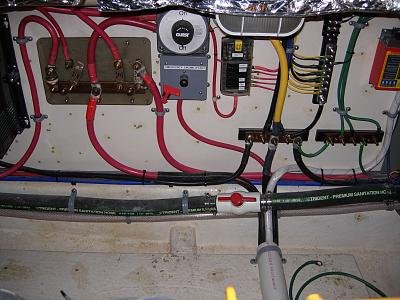I apologize that I don't have a better picture available at the moment. The below one is during the refit, is incomplete, and lacks the lexan cover on the positive buss.
It's important to be clear on this point. On DC circuits, there is a positive, a negative, and a boat bonding system (sometimes referred to as a ground). THIS BONDING SYSTEM IS NOT THE GROUND FOR ANY OF THE 120 VAC SYSTEM (shore power or generator).
In the picture the positive buss is to the left, negative in the center, and boat bonding system to the right.
The positive distribution buss has the battery bank with disconnect switch above, second alternator under the same bolt as the battery bank, and then fused leads to the main breaker panel, windlass, dinghy crane, and inverter / battery charger.
The negative buss has the battery bank cable (yellow) coming from the top, second alternator under the same bolt as the battery bank, and then leads to the main breaker panel, windlass, dinghy crane, inverter, and 3 other negative busses.
The bonding system hasn't been finished in this picture, but you can clearly see a cable between the negative buss and the bonding buss.
To your question:
Depending on where the negative wire from the battery bank is attached to the engine, you can have several pieces of metal bolted together that form the electrical path between the alternator and the negative battery cable. Certainly not optimal for a low amperage alternator (but acceptable). This adds a fair amount of resistance and possibly poor multiple connections for a high output alternator in full output tied to a house battery bank. IMO, running tinned multi strand copper cable from the battery negative buss to the alternator frame seems like a no brainer. BTW, there is also a negative cable to the engine starter flange.
View attachment 105099
Ted

